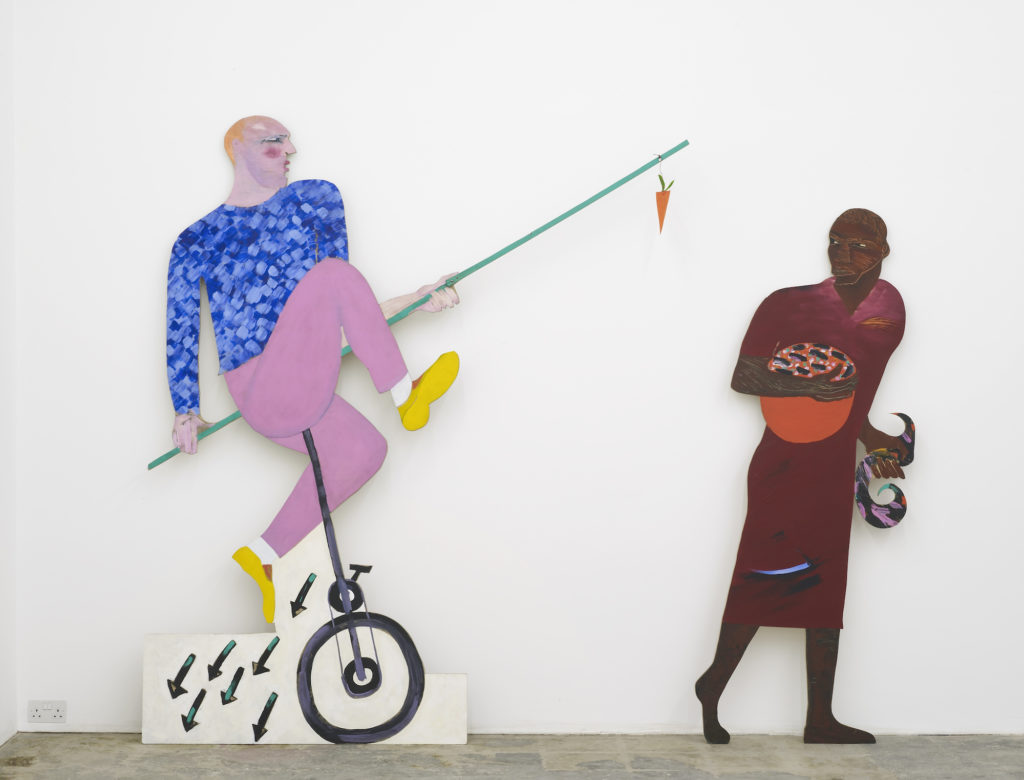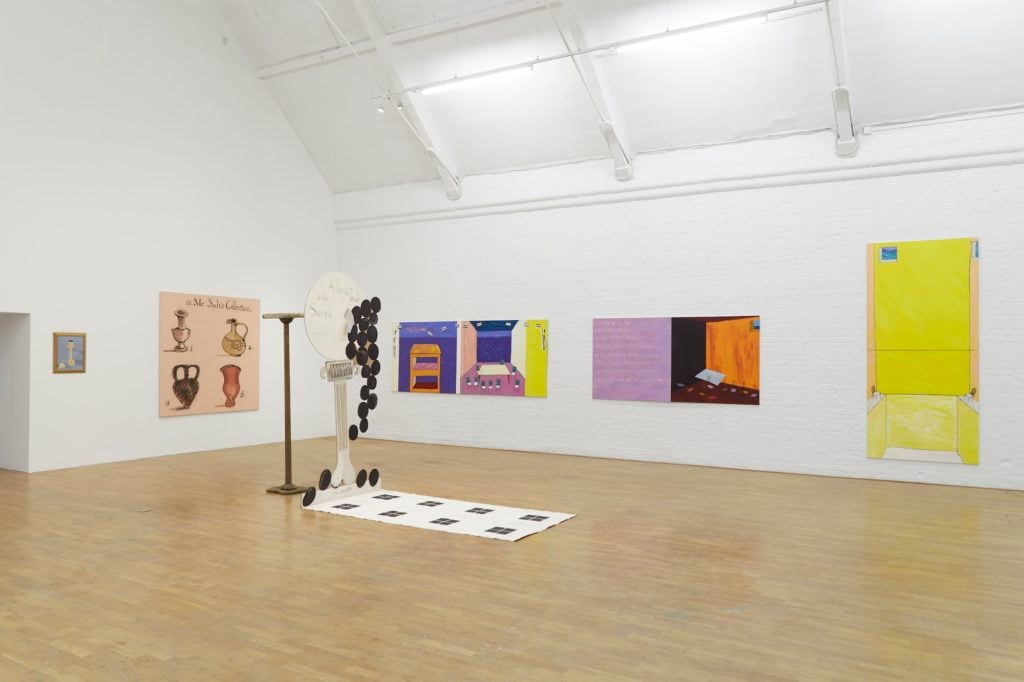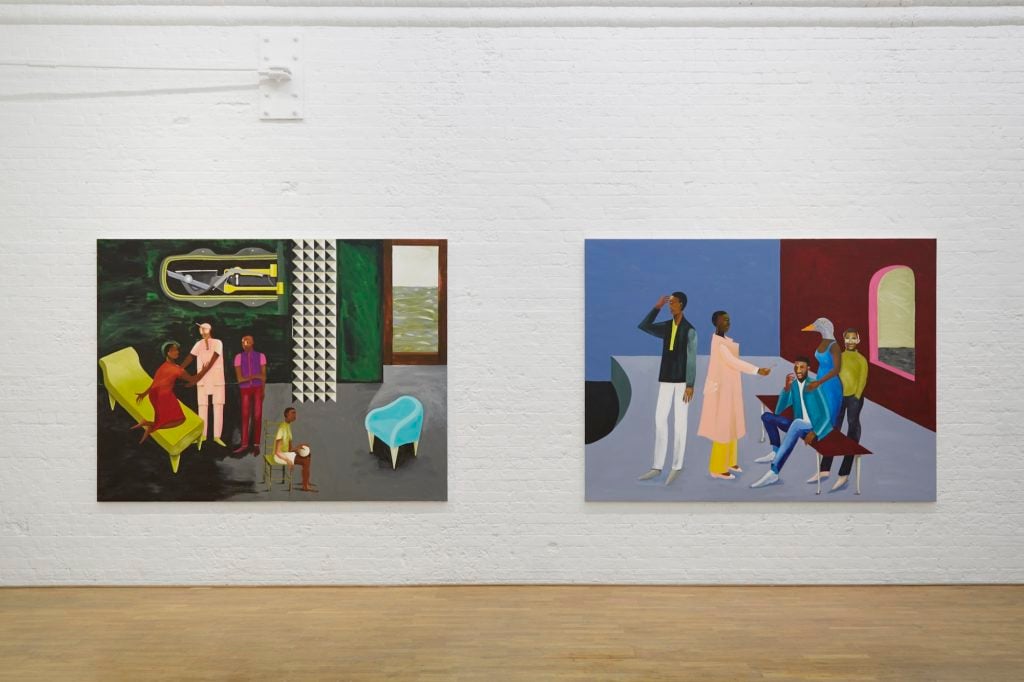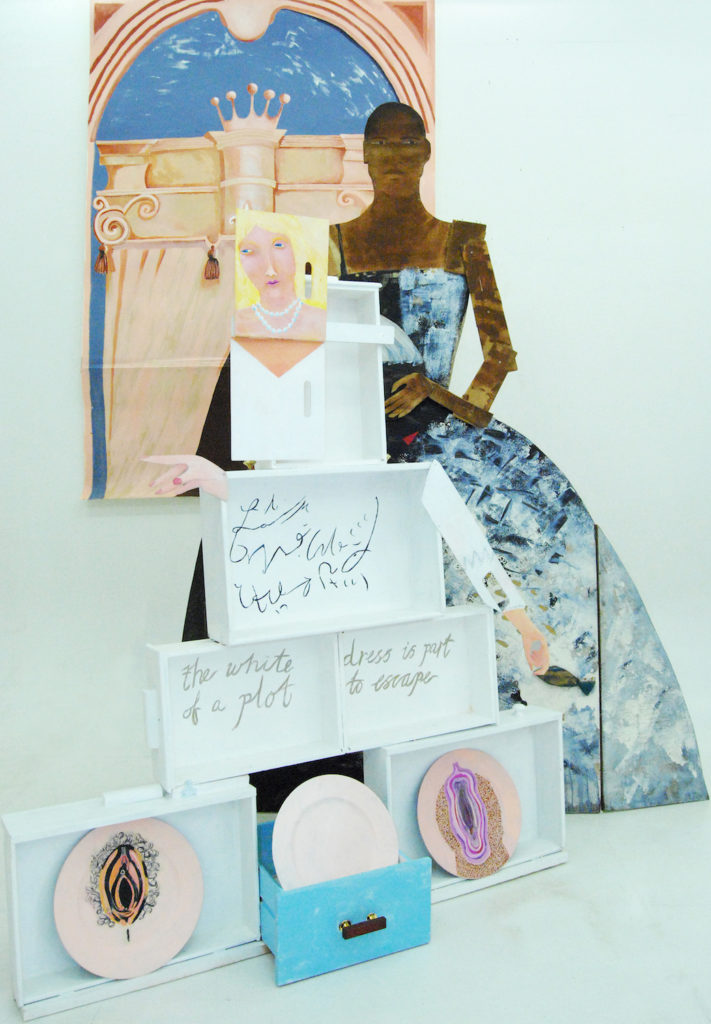Reviews
Lubaina Himid’s Riotous Art Tackles Black History and Representation Right When It’s Needed
The British artist is the subject of concurrent surveys at Modern Art Oxford and Bristol's Spike Island.

The British artist is the subject of concurrent surveys at Modern Art Oxford and Bristol's Spike Island.

Lizzie Lloyd

It’s a rare thing, for art that is resolutely politically engaged to be also a riot of joyous color and pattern. But Lubaina Himid’s concurrent large-scale survey shows at Modern Art Oxford and Spike Island in Bristol, which both opened this past weekend, are just that.
Generous, but not overcrowded, the shows’ hangs lend much needed insight into the voracious visual and cultural curiosity of the Preston-based 60-something. The works range widely between the abstracted and the figurative, the documentary and the fantasy-filled, the satirical and the deadpan, the sculptural and the textural.

Lubaina Himid, “Invisible Strategies” installation view. Photo Ben Westoby ©Modern Art Oxford.
An ever-present thread through her work, which both exhibitions make clear, is its intense painterly visuality; reinforcing, rather than distracting from, Himid’s overarching message around the politics of Black History and representation.
It is because of their visual exuberance that Himid’s works compel; their force, as a medium for social and political change, stems from their ability to pique and hold our attention. Her palette, especially in a series like Plan B (1999–2000), is just as forthright as her message: fiery oranges clash with cobalt, lilac/magenta with a spiky acid yellow.
Born in Zanzibar but based in the UK since she was a child, Himid calls herself “a political strategist who uses a visual language to encourage conversation, argument, change.” But this statement does a disservice to the lyrical and oblique ways in which she interrogates and makes Black History known.

Lubaina Himid, “Invisible Strategies” installation view. Photo Ben Westoby ©Modern Art Oxford.
As mainstays of her work, color and pattern are often used to take the measure of the emotional resonance of the work’s subject matter. In her most abstract and least explicitly political series, Zanzibar (1999), the palette takes a turn for the melancholic. Diluted aquamarines, lemon yellows, baby pinks or warm browns are poured, with control, or splashed across the canvases. Overlaid is a partial mesh of pencil-drawn and painted-in geometric pattern in colors and tones that complement and merge with the washes beneath. But even these hint at an alternative narrative reading, with shells or cloves (one of Zanzibar’s main export crops) dotted among the patterns.
Elsewhere, Himid’s sustained challenge to the status quo—in making manifest Black presence through her interrogation of the centuries-long history of the transatlantic slave trade, the canon of Art History, advertising and journalism—is full frontal. She brings to bear these issues through a canny ability to negotiate the fine line between highlighting specific examples of colonial atrocities, while leaving space for her viewers’ imagination.
In Himid’s hands, Black History is neither rammed moralistically down your throat, nor is it sidelined; it is given voice by its omnipresence. Le Rodeur series (2016), for example, takes as its starting point a historical event. In 1819, after the crew and slaves of the French ship Le Rodeur were blinded by an unknown disease during their transatlantic passage, many of the slaves were thrown overboard. Had it not been for an insurance ledger, of all things, the event would never have been recorded. Himid consistently resists the trap of illustrating the horror of events like these. Instead, she injects this work with an angularity and discomfiting foreboding that is harder to articulate and takes longer to process. Her work, in other words, makes a commitment, which takes time, like the responses she clearly hopes to engender.

Lubaina Himid, from Naming the Money (2004). Photo Andy Keate, courtesy the artist and Hollybush Gardens.
“Navigation Charts” in Bristol focuses primarily, though not exclusively, on the more sculptural elements of Himid’s work. Spike Island’s gallery two is crammed full of 100 life-size cut-out figures arranged around the room. Naively painted, in patterned dress, the figures in Naming the Money (2004) are depictions of highly skilled black slaves. No longer pushed to the side of aristocratic 17th century paintings, these ceramicists, herbalists, dog trainers, map makers, shoe makers, painters, dancers, and musicians take center stage. And it is you, the viewer, who must pick a route around them, taking a sharp intake of anxious breath as they sway in your wake. The room fizzes with the slaves’ energy, a veritable celebration of their creative skill. That this ebullience is built on horror is never far from your mind as the balance sheets stuck to the back of the unpainted cut-outs make plain. “My name is Walukaga,” reads one, “They call me Sam / I used to chase wild boar / Now the dogs do it for me / And they have the meat.” Texts like these are repeated over and over.
A more understated presence across the two shows is the idea of juxtaposition. The assortment of ornate bric-a-brac of Swallow Hard: The Lancaster Dinner Service (2007), for example, sees each vessel overpainted by Himid with a contrastive pattern, natural imagery, or satirical cartoons à la William Hogarth. The array of framed double paged newspaper articles from The Guardian are also painted over or partially redacted. The headline of one reads “Venomous Venus [Williams],” to which Himid contributes a thoughtfully doodled winding snake—a warning of the perils of inadvertent racism.

Lubaina Himid, Naming the Money (2004). Photo Andy Keate, courtesy the artist and Hollybush Gardens.
Even the Zanzibar works carry an element of contrast between the looseness of the washes and the overlaid geometric patterns. In other works, montages of women wearing Himid’s elaborately designed “Kangas”—fabrics in two pieces that would be worn on the body and head—accompany her designs. Snippets of collage are also scattered through the army of figures in Naming the Money—a Picasso-style portrait made from magazine cut-outs here, a torn up map there. Such montages and textural contrasts offer a powerful visual metaphor for the possibility of intercultural exchange and multiculturalism, while registering the discordant, palimpsestic, and fragmented nature of identities.
The move to coordinate this survey of Himid’s work between Modern Art Oxford and Spike Island is smart. Not only does the double bill echo the themes of doubling that appear throughout her work—think of the double page newspaper spreads, the kangas split into two, the canvases of the Zanzibar series being made of two halves—it also sees two mid-sized public arts institutions pooling resources, having cross-institutional conversations, and hitting above their weight in the process.
The level of press interest in these shows is proof enough of that. What is more, these shows are timely indeed. At a moment in history when exploitation is still entrenched, mass displacement ongoing, and racial, sexual, and economic inequality increasing, Himid’s message feels as fresh and as urgent as it was in the 1980s, when she first gained critical notoriety.

Lubaina Himid, A Fashionable Marriage (1986), included in “This is the Place” at Nottingham Contemporary. Photo M. Birchall & Teo Lashley Burnley, courtesy the artist and Hollybush Gardens.
The Oxford and Bristol shows also coincide with “The Place is Here,” a large scale group exhibition of pivotal Black British artists from the 1980s at Nottingham Contemporary opening on February 4, which focuses in particular on the use of montage in the works of the 30 exhibited artists.
Lubaina Himid’s “Navigation Charts” is on view at Spike Island, Bristol, from January 20 – March 26, 2017. Himid’s “Invisible Strategies” is on view at Modern Art Oxford from January 21 – April 30, 2017.